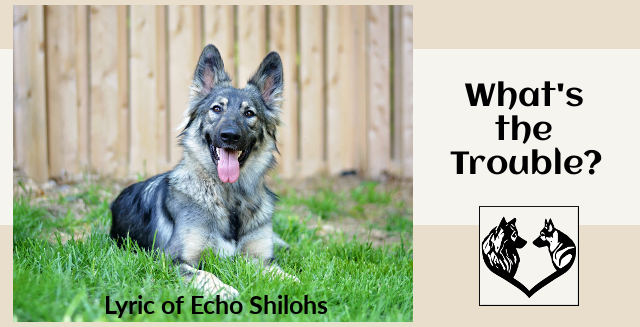
The Idea Behind Outcrossing
So, how did we get here? Why are we considering doing this? Let us give you a short introduction.
All the Dogs in the World
First, imagine all of the domestic dogs in the world. They're all part of the same species; they all came down from the same groups of wolves that were originally domesticated, tens of thousands of years ago.
Here and there over thousands of years dogs have sometimes crossbred back to wolves or even coyotes, maybe mixing in some new genes here and there, but mostly dogs have been bred to dogs as humans sought to create helpers who would hunt, herd, protect, or just be our friends. They created families of dogs that were very good at the jobs they needed to do.
Eventually, someone came up with the idea to keep track of who was bred to who, and dog registries were born--and also, the concept of the "purebred" or "pedigreed" dog, which would only be bred within its own group of dogs, who looked and acted similarly to each other.
So now, imagine all those breeds and groups of dogs across the world. They all have a different portion of the genes from those progenitor wolves. The portion may be different because of geography, or because the dog is a Collie that has been bred only to other Collies. But if you mixed all those genes back together you'd still have something that was totally "dog."
This notion of each population having a portion of the genes from the first dogs is very cool. It means that some breeds have large groups of genes that have been totally lost to other breeds, and that some populations of dogs in Africa and Asia possess rare genes that no other dog breeds still have!
Except...there's a downside. That downside is that populations don't stay in perfect balance; they are always in danger of losing genes.
Lost Genes, Lost Health
How does that happen? Well, imagine...you have a puppy. He got one half of his mom's genes and one half of his dad's genes. If he is the only puppy from those parents that goes on to breed...what happens to the other half of the genes from his mom and dad? The halves he didn't inherit?
That's right. They're lost. Take it a step farther. What if a large group of dog breeders want to breed to a few specific dogs instead of using ALL the potential breeding dogs out there? Yep...more genes lost, from the dogs that weren't used. In a healthy population, those genes probably exist elsewhere...but maybe now they're fewer. If they didn't exist anywhere else in the breed, they're lost for good. And the genes from those dogs that got bred to a lot--both good, and bad--are suddenly a lot more numerous.
There's a term for this process, where some genes become more numerous and some become rare or lost over time. It's called "genetic drift" and it happens in nature--but it can happen a lot faster in a small gene pool under human selection.
In this way, bit by bit, down through the generations, genetic diversity can be lost. And the number of genes in these populations, or breeds, becomes very condensed, very concentrated. There isn't as much "wiggle room", and bad genes--mutations--have a better chance to pile up. When two of those genes match up? Then maybe a puppy gets epilepsy. When more diversity is lost? Then a puppy might get a weaker immune system, maybe some allergies. Or any number of a host of other things that can happen when the healthy genes that should be there...aren't there anymore.
For many breeds--including ours--the diversity is less than ideal. We know this, because geneticists have started to map it. Our UC-Davis Diversity Study revealed that Shiloh Shepherds have less genetic diversity than any other breed tested so far by that program. That means the future could hold big trouble for our Shilohs.
Unless something is done about it, today.
How Do We Fix This?
What do we do to help our dogs? Are those genes really "lost for good"? Well, not if you think back to those progenitor wolves and realize that, though they may physically look different, all these dogs are still--dogs. Some of the healthy genes that used to be there in all dogs might have been lost from the Shiloh Shepherd--but they might still exist in an Irish Wolfhound. Or a Poodle. Or a Malamute.
Which brings us to the fact that the only way to bring new healthy genes into a closed population is by bringing in a dog that is at least partially unrelated. In actuality--the more unrelated, the better, because then you can gain a lot more fresh genes.
The idea, then, is to crossbreed on a limited basis, to mix in "fresh blood" from other breeds. It's not a revolutionary idea, and in fact there are other breed organizations all over the world utilizing crossbreeding projects just like this, for the same reasons.
But we don't want to change the Shiloh Shepherd--we love Shilohs, that's why we're here! Obviously the goal is not to create a bunch of mixed-breed Shiloh crosses; the goal is to infuse fresh genes for health, but still preserve the "Shilohness" of Shilohs.
So is it possible to crossbreed, retain the diversity we get, but still return to the appearance and temperament that is so unique in our Shilohs? Read on.
Go to Part Two: How does it work?
- Click here to go to our next page, "What is the ISSA trying to accomplish?"
- Click here to return to the main Genetic Diversity page.
- Want to read more about our Genetic Diversity study with UC-Davis? You can check that out here to see what stage we're at.
- If you'd like to look at our upcoming litters, including outcross litters, you can read about them here.